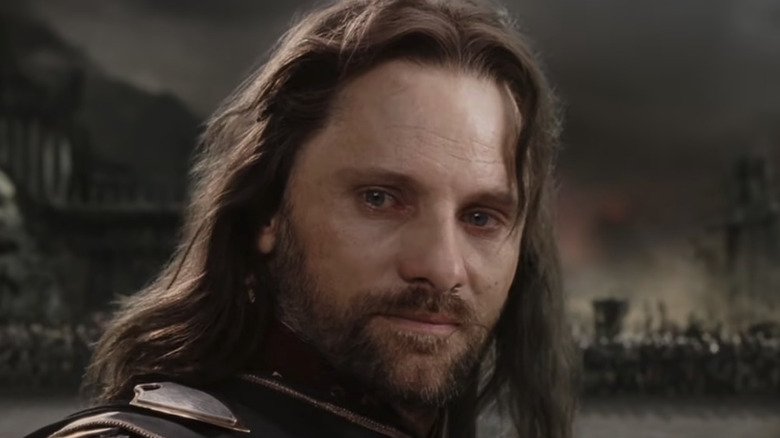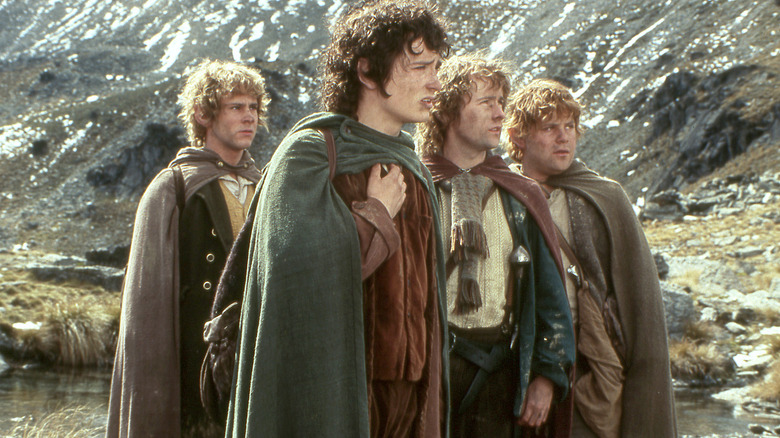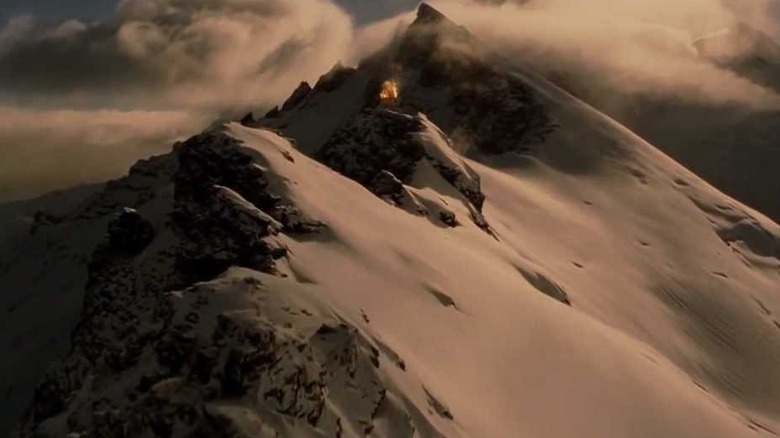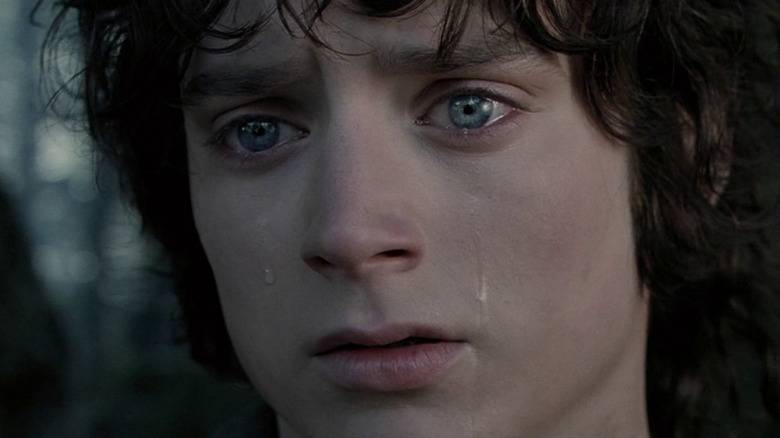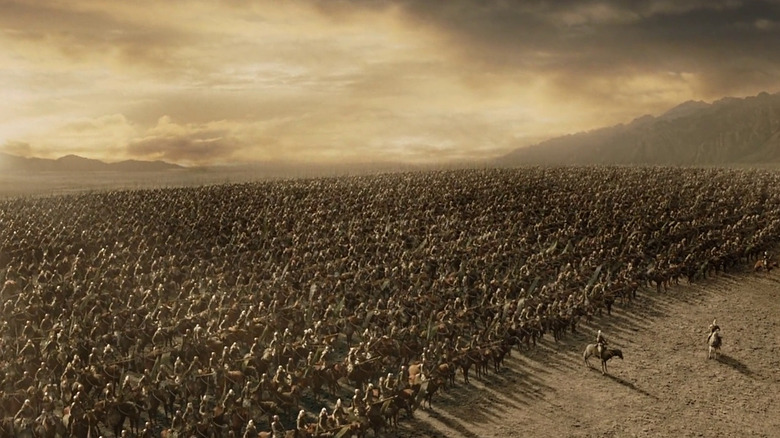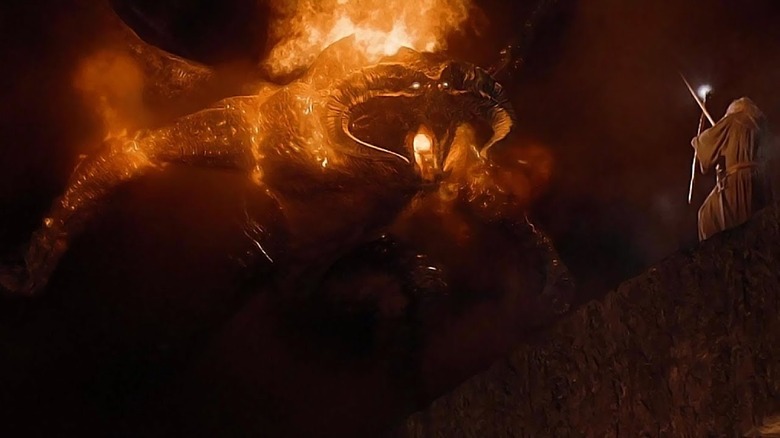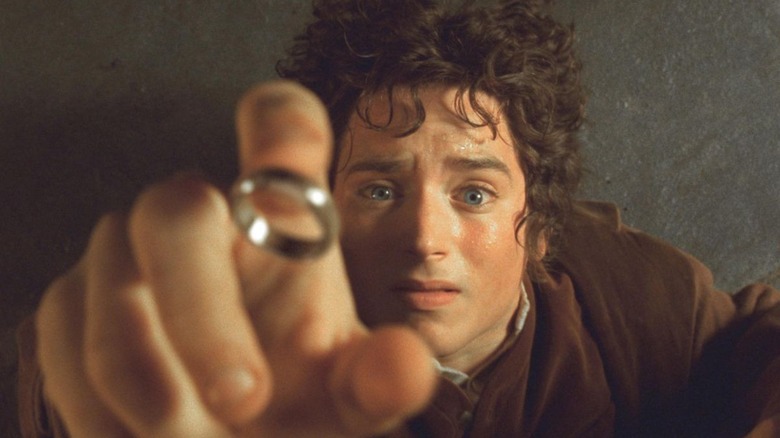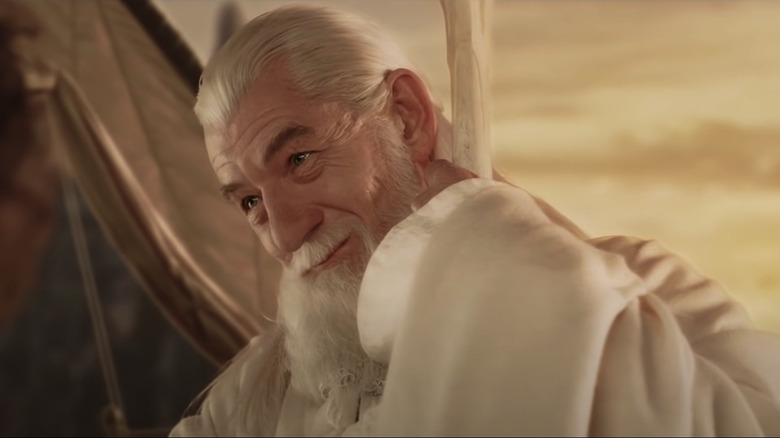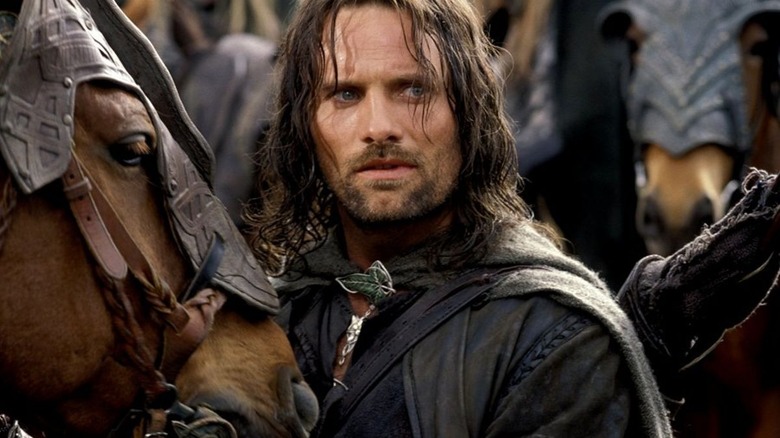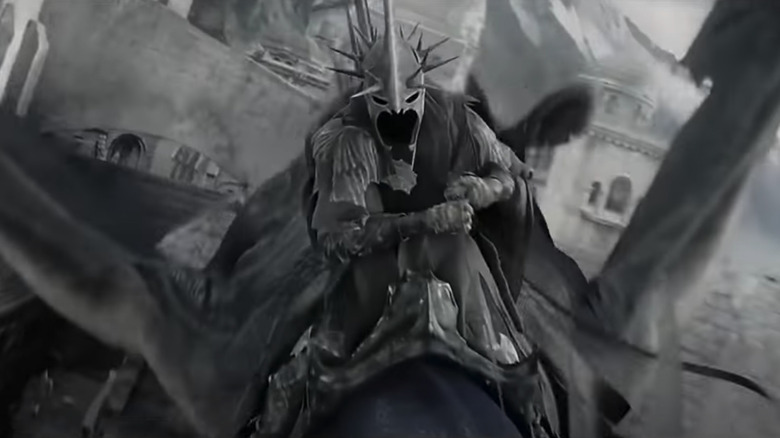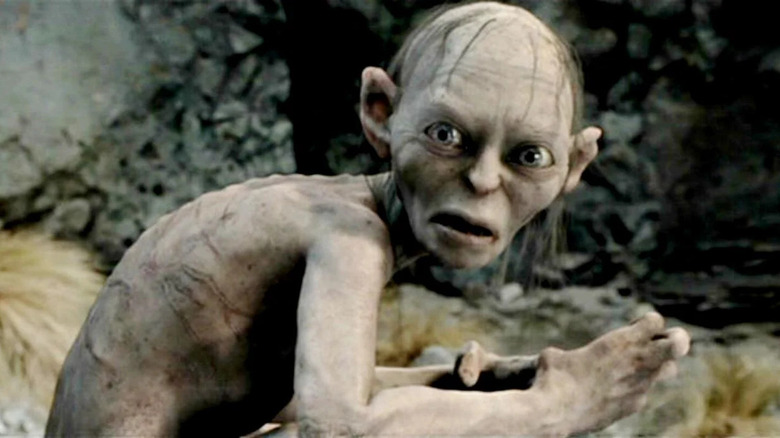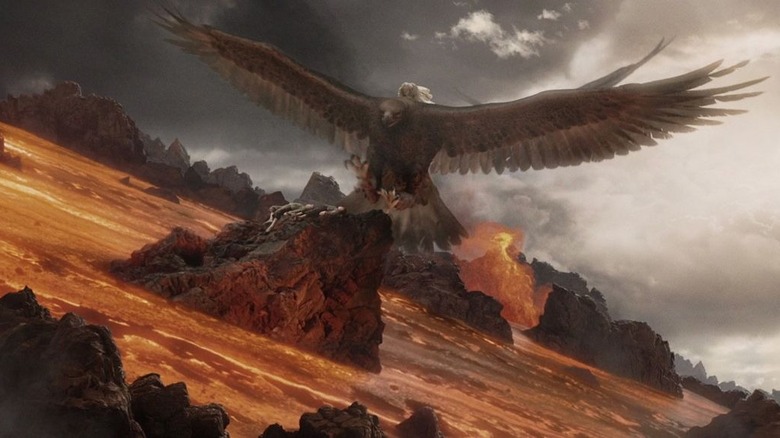These Things Happen In Every Lord Of The Rings Movie
The world that J.R.R. Tolkien created is unique. It's a one-of-a-kind wonder that other fantasy books, shows, and series have tried and failed to recreate for half a century. From the extreme depth of characters to linguistic complexities, hopeful storylines to massive historical context, Middle-earth is without equal.
And yet, within its own four walls, there are many elements that consistently take place in Tolkien's world. The author regularly goes to the same well of inspiration for things like epic last stands and evil temptations. Many of these repetitive tropes translated into Peter Jackson's highly lauded cinematic adaptations, too. In fact, the director went ahead and tossed a few more predictabilities into the mix.
With that in mind, we decided to comb through the 11-plus hours of extended "Lord of the Rings" footage (Jackson's versions only) and look for the recurring items that really stand out. We're talking about the kind of things that, one way or another, always find a way to pop up in each film.
There's a lot of traveling going on — like, a lot
Every "Lord of the Rings" film is filled with a lot of walking, hiking, and traveling in one form or another. Fan site TheOneRing.net estimates that Frodo walks a painstaking 1,800 miles from his front doorstep at Bag End to the fires of Mount Doom. And that doesn't even factor in the part where the Fellowship splits up and we start tracking a bunch of different offshoots of the Ringbearer's party.
Whether we're watching our heroes boat down the Great River Anduin, ride across the plains of Rohan, fly on the backs of Eagles, or otherwise walk, climb, and scramble across dozens of other Middle-earth landscapes, there is a lot of traveling that happens throughout these movies.
The thing is, getting from point A to point B isn't just something that's happening a lot. It's a central part of the story. Not long after that epic opening sequence in "The Fellowship of the Ring," it becomes clear that the primary objective of all of our heroes is to get Frodo to Rivendell. From there, it takes a hot second before the poor Hobbit and his friends are tasked with the even longer journey of getting to Mount Doom. No matter what way you slice it, traveling is a huge part of every installment of this story.
Epic moments are par for the course
Middle-earth is overloaded with epic moments. Sometimes these take the form of a gigantic dragon-shaped firework or Black Riders chasing down Hobbits in the woods and lanes of the Shire. At other times, the scale increases, as is the case when Pippin lights the beacons of Gondor or the Ents attack Isengard. Many other battles are also scattered throughout the story, from Helm's Deep to the Pelennor Fields to the Black Gates of Mordor.
If there's one element that truly sums up the epicness of Peter Jackson's movies, though, it has to be the New Zealand landscapes. All three films are filled with gorgeous panoramic shots from the Land of the Long White Cloud. "The Fellowship of the Ring" features a number of mesmerizing scenic visuals as the Fellowship travels south from Rivendell. "The Two Towers" opens with a stunning visual of the Misty Mountains. Minas Tirith is shown nestled into a similar southern edifice in "The Return of the King."
Couple these shots with the right music (more on that elsewhere) and you can count on feeling stirred in your seat no matter which of the three movies you're watching.
Emotions run high and low and then high again
It doesn't take long for the emotional roller coaster that is "The Lord of the Rings" to start pulling on everyone's heart strings. The emotional beats run throughout the story in many different forms, too, starting with the warm and fuzzy sentiment of the Shire.
From there, we're treated to a cacophony of different emotive cinematic elements. The comforts of the Hobbit homeland are quickly replaced by the thrill of a high-speed chase to Bree, where soggy, gloomy danger continues to lurk. We get a short rest in Rivendell and then spirits are lifted high again when the Ring is whisked away toward Mordor. Then Gandalf falls in battle with a Balrog and everyone's spirits are crushed. Lothlorien rehabilitates those happy feelings again, only for the audience to witness Boromir's death and the breaking of the Fellowship — and that's just the first movie.
Every "Lord of the Rings" movie is riddled with emotions that vacillate between epic highs and devastating lows. It's part of the Tolkien experience, and a major element that has made the films resonate with multiple generations of viewers over the years.
The music is always incredible
Howard Shore's score for "The Lord of the Rings" is rightly considered one of the greatest elements of the films. The venerable composer received not one, not two, but three Academy Awards for his labors, not to mention two BAFTA nominations and three Grammys (per IMDb).
The man has been showered with accolades — and not just for one movie, but for all three. Shore's Middle-earth soundtracks are one of the essential ingredients that tie the "Lord of the Rings" trilogy together. (They're also one of the few stand-out elements in the less-heralded "The Hobbit" trilogy.) It also knits together the three-part "Lord of the Rings" story into a single, emotionally-uniform experience.
The score of a film is always important. But there are few greater examples of this than Shore's soundtrack for "The Lord of the Rings." It's an iconic part of all three movies that fans can always expect to hear playing in the background, moving them to tears, sparking joy, and consistently bringing them to the edge of their seats.
Set-piece battles are predictable centerpieces
"The Lord of the Rings" may be a story filled with an interminable amount of traveling, but the Fellowship of the Ring's collective Middle-earth tour is consistently interrupted by one thing, in particular: set-piece battles.
In the first movie, there are multiple duels, like Aragorn's fight with the Ringwraiths on Weathertop, the Fellowship's tussle with a troll in Moria, and Gandalf's downing of the Balrog on the Bridge of Khazad-dûm. By the second installment, we see epic clashes, like those at Helm's Deep and an Ent-ridden Isengard. In the third movie, the set-pieces reach a fevered pitch as battles break out at Minas Tirith, on the Pelennor Fields, and even in front of Sauron's own Black Gates. No matter which movie is in the queue, set-piece conflicts are going to show up from time to time, and the audience can plan on a steady dose of pre-determined action as they work their way there and back again across the Middle-earth landscape.
Frodo will be tempted to put on the Ring
He may not look it at first glance ... or even at second glance. But Frodo is one of the strongest members of the Fellowship of the Ring. The little Halfling holds an inner strength of will that is unrivaled among Dwarves, Elves, Men, and even Wizards. It's an inner courage that prompts Gandalf to tell Frodo that "you have some strength in you, my dear Hobbit" when Frodo arrives at Rivendell after being chased, stabbed, and then chased again by Black Riders.
While Frodo is a spunky little guy, though, that doesn't mean he's invulnerable. On the contrary, the protagonist is steadily tempted by the Ring, and eventually is so consumed by it that he can't even willingly destroy it (thanks Gollum).
This inner struggle between his own will and that of the Ring drags on throughout all three movies — which is why one easy "Lord of the Rings" staple is that we see Frodo constantly struggling with the temptation to put on the Ring. He's shown stroking it in Bree. He almost puts it on while facing a Black Rider in Gondor. He snatches it away from Sam after escaping Shelob ... and then finally caves in and puts the darn thing on when he reaches Mount Doom, almost ruining everything in the process. Frodo's back and forth battle with the Ring isn't a one-off occasion — it's a consistent element that takes place throughout the entire trilogy.
Gandalf is always pulling the strings
In the source material, Tolkien makes it clear that Gandalf isn't interested in leading. He prefers to orchestrate events from behind the scenes. This prompts Saruman in "The Fellowship of the Ring" book to belittle the Grey Wizard by saying, "It has seldom been heard of that Gandalf the Grey sought for aid, one so cunning and so wise, wandering about the lands, and concerning himself in every business, whether it belongs to him or not." In "The Return of the King" book, Denethor harps on this, too, when he accuses Gandalf by saying, "Thy hope is to rule in my stead, to stand behind every throne, north, south, or west."
While Gandalf's opponents may criticize his activities as backdoor politicking and king-making, they kind of have a point. He's the one that gets Frodo to leave the Shire. He sets the stage for the Council of Elrond to send the Ring to Mordor. He saves Théoden and stages Helm's Deep. He rides ahead to protect Minas Tirith. He's involved in the decision to attack the Black Gate.
The thing is, Gandalf doesn't actually make many of these decisions. Instead, he provides information, offers nuggets of wisdom, and gently guides others toward making the right decisions. It's subtle. It's also always done in the name of good. But it doesn't change the fact that Gandalf is tirelessly working behind the scenes throughout all three movies.
Aragorn struggles with his destiny
One of the major changes that Peter Jackson made when adapting "The Lord of the Rings" books to a shorter (yes, the nearly 12 hours of extended footage is technically shorter than the books) cinematic format was to make Aragorn's character a bit more accessible. In the source material, the Ranger enters the story as a hero that is fully aware of and laser-focused on his destiny.
In the movie version, Aragorn is anything but certain about his future. He wrestles with his heritage and hesitates to step forward when the time comes. This doesn't just happen in one movie, either. It's an ongoing struggle throughout all three films.
When we first meet the exiled King, we see Arwen giving him pep talks. By "The Two Towers," he's started to hesitantly step into the limelight, particularly when he plays a key role in the defense of Helm's Deep. By "The Return of the King," he finally accepts his role as a defender of the West and one of the primary foes of Sauron. While Aragorn does eventually accept his destiny, it takes him all three movies — along with a lot of drama along the way — to do so.
Saruman gets saucy
Saruman is quite the wizened fellow by the time of "The Lord of the Rings." When the story begins, the spiritual being is eons old and has already been traipsing around Middle-earth in his shriveled Wizard body for thousands of years. Even so, it appears that his long life and past experiences haven't toned him down much. Quite the opposite. Saruman finds a way to get arrogant and uppity at least once in all three "Lord of the Rings" movies.
In the first movie, we see him disrespect Gandalf multiple times, including accusing him of being a pipeweed addict. By the second film, we see him insulting Wormtongue on a regular basis. When he appears for the last time at the beginning of the extended edition of "The Return of the King," the Wizard breaks down and starts hurling insults (and fireballs) from the top of his tower.
Saruman may be a powerful Middle-earth Wizard. He even creates a giant army of Uruk-hai to do his bidding. But the power clearly goes straight to his head, making him predictably impudent pretty much every time we see him.
The Ringwraiths scream at everything
There's a lot to love in Peter Jackson's iteration of Middle-earth. The adaptation is moving, inspiring, and flat-out gorgeously produced. The story is narrative gold largely taken right from the pages of Tolkien's books. Even though all of the ingredients are present to make the recipe a success, though, that doesn't mean every single element is praiseworthy. On the contrary, there are plenty of nit-picky things to criticize, including some that show up in every single movie.
Case in point: the Black Rider screech. The bone-chilling sound was reportedly created with little more than a couple of cups being rubbed together before being beefed up in edit. Nevertheless, the sound is terrifying. It sends shivers down the spine. It causes folk to stop their ears — as is the case in the actual story, too.
The Ringwraith screech is also terribly, constantly, and overwhelmingly consistent throughout all three movies. They show up early and often, hurting the ears of their enemies and the audience alike. It doesn't matter if you're watching Frodo flee from the Shire, Faramir drag his captured Hobbits back to Gondor, or Minas Tirith come under siege. The Ringwraiths are always there, screeching, screeching, screeching.
Gollum tracks Frodo over and over again
One kind-of odd piece of trivia that happens in every "Lord of the Rings" movie is the fact that Gollum actively tracks Frodo. Yes, we see him doing it three separate times.
The first occasion is easy. When Gollum is finally revealed in "The Fellowship of the Ring," it's in the Mines of Moria, where he's quietly tracking the Fellowship. In "The Two Towers," the poor wretch is caught tracing Frodo and Sam through the craggy range of steep hills known as the Emyn Muil. Once he's tamed, Gollum leads his captors ... straight to Shelob's lair. There he appears to have died, tumbling off a cliff. But — hey, presto! — he makes a comeback in "The Return of the King," and what is he doing? Why tracking down Frodo, of course.
Gollum plays a critical role in the story. He's equal parts necessary victim and active antagonist. And yet, he doesn't spend much of his time in the spotlight. On the contrary, a significant portion of the sneak's time is occupied tracking down and following the Ring-bearer from a distance.
You can always count on a eucatastrophe
"The Lord of the Rings" is a sad story. It focuses on things like the slow decline of the Elves and the end of an era that was once beautiful and full of life. And yet, Tolkien always wrote with a sense of hope and a dash of the unexpected. This led to the author coining the word eucatastrophe, which he personally defined as "'the sudden happy turn in a story which pierces you with a joy that brings tears (which I argued it is the highest function of fairy-stories to produce)."
"The Lord of the Rings" is riddled with eucatastrophes. Gandalf's return as the White Wizard is one. Reinforcements arriving just as Helm's Deep is about to fall is another. So is the charge of the Rohirrim at the Battle of the Pelennor Fields. The arrival of the Eagles at the Black Gate is also a eucatastrophe. One could even argue that Boromir's repentance and heroic death are a form of eucatastrophic glory compared to the corruption he was caving into moments before.
There are many predictable things that happen throughout "The Lord of the Rings," and a eucatastrophe of one form or another is definitely one of them. It's a happy fact that collectively makes us glad and keeps everyone coming back for more, as it should.
